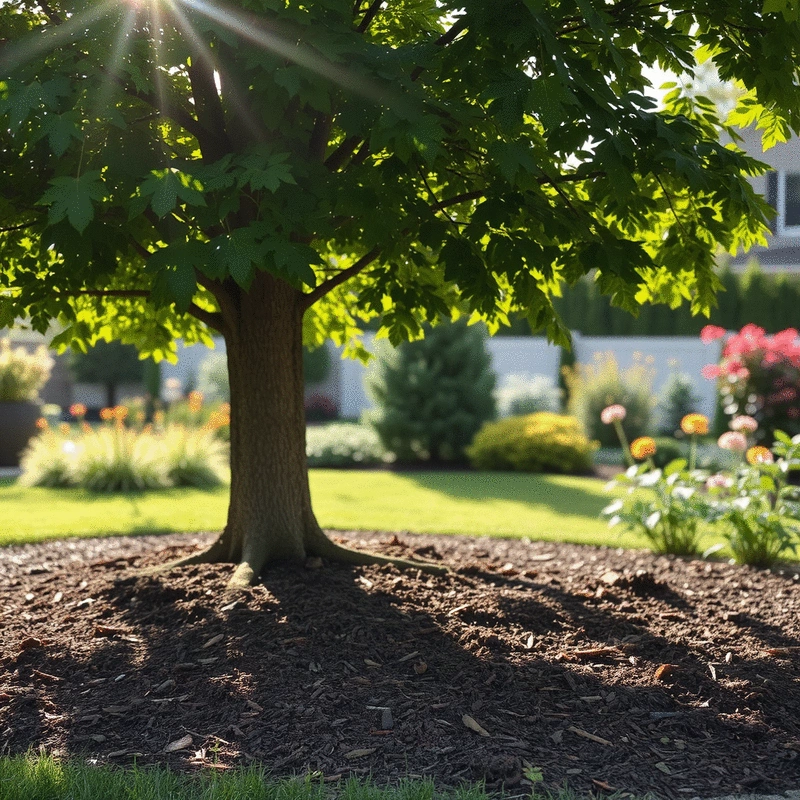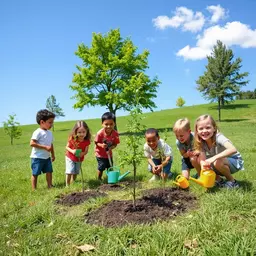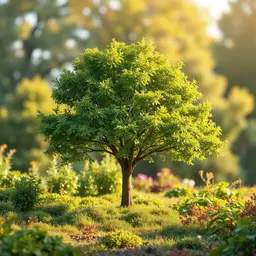Mulching Benefits for Tree Health

Mulching is more than just a gardening technique; it’s an essential practice for nurturing tree health and the surrounding environment. With the right approach, you can ensure that your trees thrive, contributing to a healthier ecosystem. Here's what you will learn about this often-overlooked method!
What You Will Learn
- Mulching acts as a protective layer, keeping tree roots warm, retaining soil moisture, and suppressing weeds.
- Applying mulch improves soil quality over time, enriching it with nutrients that support tree and plant growth.
- Proper mulching practices can prevent issues such as root suffocation, fungal diseases, and pest attraction caused by over-mulching.
- Using organic mulch materials boosts microbial activity, enhancing soil structure and making nutrients more accessible to trees.
- Mulching contributes to water conservation and erosion control, making it a sustainable practice that benefits both trees and the environment.
Key Benefits of Mulching for Trees
The following highlights the significant benefits of mulching in promoting tree health and sustainability.
Retains Soil Moisture
Mulching reduces evaporation, keeping the soil consistently moist and lowering the need for frequent watering.
Regulates Soil Temperature
By insulating the soil, mulch protects tree roots from extreme temperatures, ensuring better growth.
Suppresses Weeds
Mulching minimizes competition for nutrients by suppressing weed growth around the trees.
Organic mulch enriches the soil over time, fostering a robust ecosystem for trees and surrounding plants.
Understanding the Significance of Mulching for Tree Health
When it comes to nurturing our trees, mulching plays a vital role that often goes unnoticed. At Timber & Thrive, we believe that understanding the significance of mulching can transform how we care for our beloved trees. By providing a protective layer around the base of trees, mulching not only enhances their health but also supports the overall ecosystem.
Think of mulching as a cozy blanket for trees! It keeps them warm, retains moisture, and even wards off pesky weeds. For anyone passionate about sustainable practices, like I am, mulching is an essential technique we can adopt to promote vibrant and resilient trees. You can learn more about nurturing trees for healthier growth through various methods.
The Role of Mulching in Promoting Tree Vitality
Mulching isn't just about aesthetics; it serves as a fundamental practice for ensuring tree vitality. By covering the soil with organic or inorganic materials, we create a favorable environment for the tree's roots to thrive. This nurturing layer acts as a barrier against harsh weather and helps to maintain consistent moisture levels.
In addition to protecting tree roots, mulching can improve soil quality over time. As organic mulch breaks down, it enriches the soil with valuable nutrients, fostering a robust ecosystem for the tree and surrounding plants. This is a win-win situation for all of us who care about our natural environment!
Defining Mulching and Its Importance
So, what exactly is mulching? It involves placing a layer of material—such as leaves, bark, or wood chips—over the soil surface. This layer protects the soil, retains moisture, and contributes to the overall health of the tree. At Timber & Thrive, we encourage everyone to embrace mulching as a simple yet effective way to promote sustainable tree care.
Understanding its importance is crucial. Mulching not only offers immediate benefits but also supports long-term tree health. Think of it as a small investment with big payoffs in the form of lush and thriving trees! For more insights, explore natural ways to grow trees.
Overview of Mulching Benefits
Mulching provides numerous advantages that are hard to overlook. Here are some key benefits that highlight why we should all consider mulching our trees:
- Retains soil moisture, reducing the need for frequent watering.
- Regulates soil temperature, keeping roots safe from extreme conditions.
- Suppresses weeds, minimizing competition for nutrients.
- Improves soil health through the addition of organic material.
With these benefits in mind, mulching becomes a powerful tool in our tree care toolkit. As we strive for a greener future, let’s not forget the simple yet impactful practice of mulching!
Key Benefits of Mulching for Trees
Now that we've explored the basics, let's dive deeper into the specific benefits of mulching for our trees. Each of these aspects contributes to a thriving tree ecosystem, making it vital for anyone passionate about sustainability.
Enhancing Soil Moisture Retention for Optimal Growth
One of the standout benefits of mulching is its ability to enhance soil moisture retention. By acting as a protective layer, mulch reduces evaporation and keeps the soil consistently moist. This is especially important during dry spells or in arid climates.
In my experience, trees that are well-mulched often require less watering, making it a practical choice for environmentally conscious tree care. Let’s save that precious water for when it’s truly needed!
Regulating Soil Temperature to Protect Tree Roots
Another fantastic benefit of mulching is temperature regulation. By insulating the soil, mulch helps protect tree roots from extreme heat or cold. This ensures that trees remain healthy and can focus their energy on growth instead of survival.
Imagine a hot summer day—mulched trees experience much less stress compared to those without mulch. It's like providing them a cool oasis, helping them thrive during the toughest weather!
Suppressing Weeds to Reduce Competition for Nutrients
Weeds can be a significant threat to our trees, competing for essential nutrients and water. Mulching helps suppress weed growth, allowing trees to receive the resources they need without unnecessary competition. This is particularly beneficial for young trees that are still establishing their root systems.
By taking this proactive approach, we're giving our trees the best chance to flourish. Weeds can be relentless, but with a good layer of mulch, we can keep them at bay! For tips on maintaining a healthy garden, consider learning about seasonal tree care for gardens.
Improving Soil Health Through Organic Material
Organic mulch, such as shredded leaves or wood chips, breaks down over time and enriches the soil with nutrients. This not only benefits the tree but also supports the surrounding ecosystem by fostering microbial activity.
This is where the magic happens! Healthy soil leads to healthy trees, and at Timber & Thrive, we understand the connection between soil quality and tree vitality.
Promoting Microbial Activity for Enhanced Soil Structure
Speaking of microbial activity, mulching promotes a bustling community of beneficial organisms. These microbes break down organic matter, improving soil structure and making nutrients more accessible to tree roots.
It's a fantastic cycle—healthy soil supports microbial life, which in turn supports tree health. Together, we can enhance our landscapes by fostering this interconnectedness!
Supporting Water Conservation and Erosion Control
Finally, mulching contributes to water conservation and erosion control. By reducing runoff and keeping moisture in the soil, we can minimize water waste. Plus, mulch helps anchor the soil, preventing erosion during heavy rains.
By mulching wisely, we’re not only aiding our trees but also taking steps toward responsible stewardship of our precious resources. Every little bit counts when it comes to protecting our planet! This aligns well with broader sustainable tree care practices.
Interactive Poll: Your Mulching Practices
We want to know about your mulching habits! How often do you mulch your trees, and what materials do you prefer? Share your thoughts below:
Addressing Common Questions and Concerns about Mulching
As we dive deeper into the world of mulching, it's essential to address some common questions and concerns that many tree enthusiasts, like myself, may have. While mulching offers numerous benefits, improper practices can lead to problems that may harm your trees instead of helping them. Let's explore some of these issues to better equip ourselves for effective tree care!
Understanding what can go wrong is just as important as knowing the right techniques. At Timber & Thrive, I’ve seen firsthand how small mistakes can lead to significant problems for our trees. So, let’s take a look at what can happen when mulching isn’t done correctly.
Potential Risks of Improper Mulching Practices
One of the most common pitfalls in mulching is **over-mulching**. This occurs when too much mulch is applied around the base of the tree, which can trap moisture and prevent proper air circulation. Here are some issues caused by over-mulching:
- Root suffocation due to lack of oxygen
- Increased risk of fungal diseases
- Unwanted pests attracted to the damp environment
It's important to strike a balance. Understanding the right depth of mulch can make a world of difference in maintaining tree health!
Frequently Asked Questions (FAQs) about Mulching
Identifying Issues Caused by Over-Mulching
Another concern arises from using incorrect mulch materials. Not all mulch is created equal, and choosing the wrong type can lead to detrimental effects on your trees. Here’s a quick summary of issues associated with poor mulch choices:
- Using non-organic materials may leach harmful chemicals into the soil
- Plastic or synthetic mulches may hinder water penetration and root growth
- Some wood mulches contain pathogens that could spread diseases
Being mindful of the materials we use is key to fostering a healthy environment for our trees. Remember, at Timber & Thrive, we advocate for sustainable practices that align with nature!
Recognizing the Impact on Tree Longevity and Health
Lastly, improper mulching can severely impact a tree's longevity and overall health. Trees that are not given proper care may experience stunted growth or even decline over time. A few critical factors to consider include:
- Potential damage to the root system from excess pressure or disease
- Lack of nutrients reaching the tree due to poor soil conditions
- Increased vulnerability to environmental stressors like drought or frost
Understanding these risks emphasizes the need for proper techniques and knowledge about mulching. It’s about creating a nurturing environment where our trees can truly thrive!
Conclusion: Embracing Mulching for Sustainable Tree Health
In summary, mulching can be a powerful tool in promoting tree health if done correctly. The benefits far outweigh the risks when we approach mulching thoughtfully and with care. I encourage everyone to embrace mulching as a sustainable practice that supports our trees and the environment.
At Timber & Thrive, I’m committed to helping you achieve success in your tree care journey. Let’s continue to advocate for responsible mulching practices that honor our ecosystem!
Call to Action: Start Your Mulching Journey Today
Are you ready to start or enhance your mulching practices? I’d love to hear about your experiences! Share your thoughts or questions in the comments below, and let’s engage in a meaningful conversation about tree care. Together, we can support our trees and create a greener future!
Remember, every small action counts. Join me on this journey to nurture our trees and foster a community that values sustainable practices!
Recap of Key Points
Here is a quick recap of the important points discussed in the article:
- Mulching acts as a protective layer, enhancing tree health by retaining moisture and regulating soil temperature.
- It suppresses weeds, reducing competition for nutrients and allowing trees to thrive.
- Organic mulch improves soil quality over time, enriching it with nutrients as it breaks down.
- Proper mulching practices are essential, as over-mulching can lead to root suffocation and increased disease risk.
- Choosing the right mulch material is crucial to prevent harmful effects on tree health.



